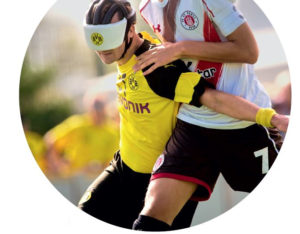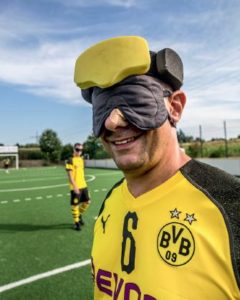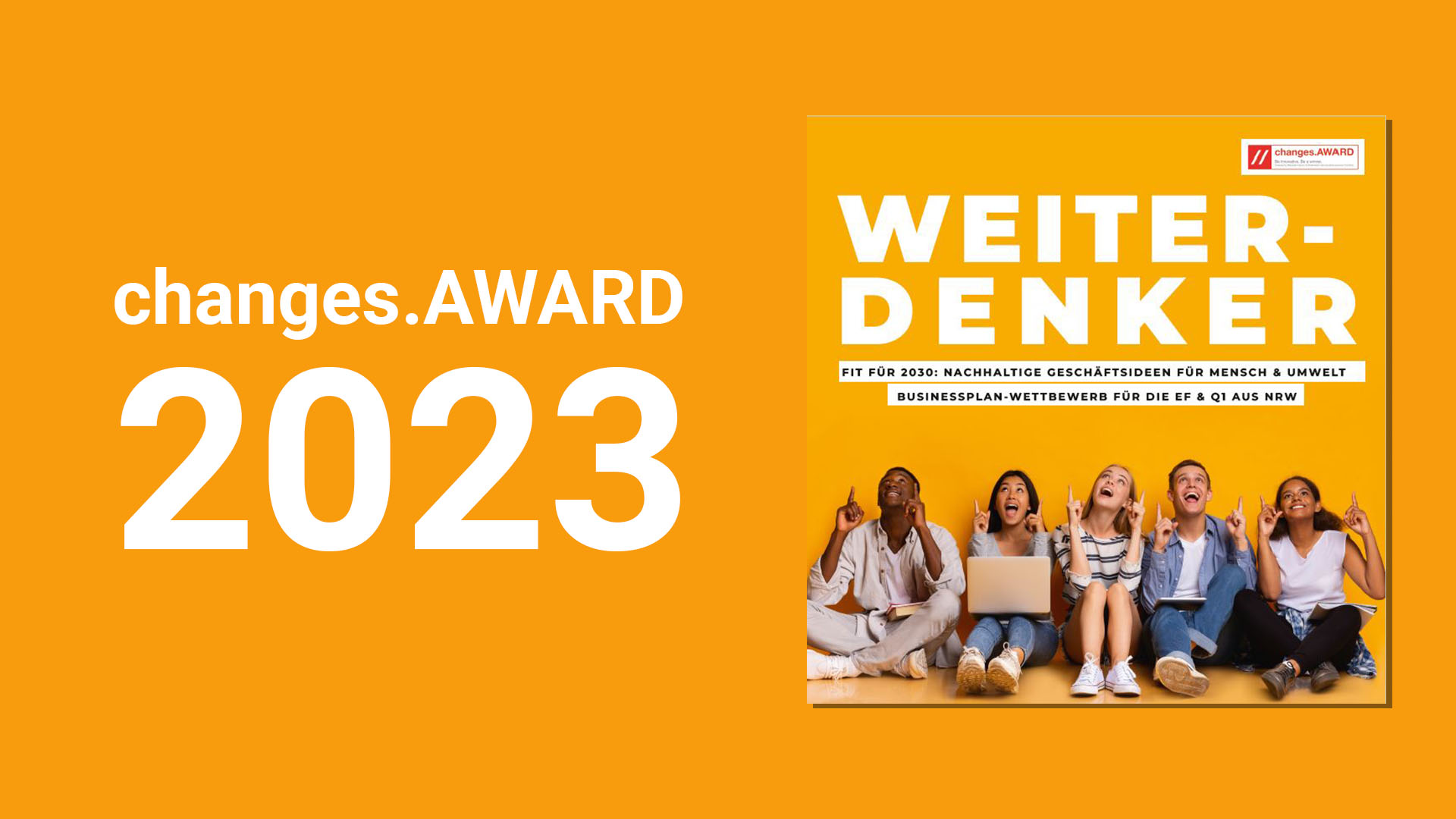Voy! I’m coming! – about the blind football team of Borussia Dortmund.
When Borussia Dortmund’s blind football team comes on to the pitch, there are no singing fans, no rhythmic clapping, no shouts and cheers coming from the south bank, where spectators are singing the “Heja BVB” anthem. Instead the atmosphere is more like what you would find at Centre Court at Wimbledon: only when a goal is scored will you hear the clapping and cheering.
That is just one of the many small differences between blind football and sighted football, though it is surely a significant one. Those who cannot see where the opposing goal is, or where their teammates are, or where their opponents are, have no choice but to rely entirely on their sense of hearing. Even more so than “regular” football, blind football is a team sport that relies on the communication and cooperation of its players.
The teams consist not just of blind footballers, but three sighted teammates as well. That includes the goalkeeper, the coach at the sidelines and the goal guide behind the opposing team’s goal. The callers give the players on the field tips and instructions, but we will learn more about that shortly. All that close teamwork, both sighted and blind, is what makes blind football something truly special for Hasan Caglikalp: “Personally, I really get a lot from the sport”, he says: “You’re just a team – whether you win or lose, we’re like one big family.”
A German summer’s fairy tale – in the world of blind football as well.

Caglikalp has been a German blind footballer right from the start. It is people like him we have to thank for the fact that an organised blind football league even exists. When the blind football Bundesliga kicked off its 12th season on 11 May, he was back out on the pitch. At over 50, he is now the oldest player in the league. He has been in the game since 2006, the year of the Sommermärchen, “a summer’s fairy tale” as it is called in
Germany, when Germany hosted the World Cup. Before his football career, he was a successful goalball player and decorated German champion. The football euphoria that swept the nation in 2006 hit him and a few of his goalball-playing friends just as hard as it hit everyone else.

Hasan Caglikalp puts his motivation at the time like this:
“I always had an affinity for sports and for football. When I was at school I played around on the cinder pitch and then went on to become a successful goalball player. As a sports official and coach, I just wanted to give football a try and was able to get some other goalballers on board. For me, high-performance sports begin with football – my colleagues and I just wanted to dare to take the next step at that point.”
In fact, blind football is in many respects a true example of peak performance. If you think of blind football as a bunch of visually impaired people carefully feeling their around the pitch with canes for the blind, you have got it all wrong: blind football is a really tough sport.
A big display on a small pitch.On a small 20- by 40-metre pitch, two teams with four blind players each take up their positions. The long sides are formed by boarding. They are intended to prevent the ball going out of play but can also be used actively during the game. There is no offside and that also makes the game quick. They play with hockey goals that are approximately 3.6 metres wide and 2.1 metres tall. A match consists of two halves of 20 minutes with a ten-minute break in between. There is a sound system in the ball so that players can hear it and locate it acoustically on the field. The sound system also makes the ball heavier, which is a welcome side effect, as it means the ball does not bounce as high and is easier to control.
 IWhen two players are battling for the ball, things can get rough. That is why the players wear head guards to minimise the risk of getting injured in a collision. The players also wear total light blackout eyeshades to ensure fair play if certain players have any remaining vision, which makes all players equal on the pitch. Another precautionary measure is that players must shout ‘Voy!’ when going in for a tackle. Voy! is Spanish and means “I am coming!” The call helps players avoid collisions. If an opponent closes in on the player with the ball, he has to shout ‘Voy!’ to alert him as soon as he comes within three to five metres of the ball. Violations are treated as fouls.
IWhen two players are battling for the ball, things can get rough. That is why the players wear head guards to minimise the risk of getting injured in a collision. The players also wear total light blackout eyeshades to ensure fair play if certain players have any remaining vision, which makes all players equal on the pitch. Another precautionary measure is that players must shout ‘Voy!’ when going in for a tackle. Voy! is Spanish and means “I am coming!” The call helps players avoid collisions. If an opponent closes in on the player with the ball, he has to shout ‘Voy!’ to alert him as soon as he comes within three to five metres of the ball. Violations are treated as fouls.
The sport is quite demanding. Not only do the footballers have to know how to take a hit; they have to have a whole lot of other skills as well: “As a player you have to have excellent orientation skills – you have to be quick and have an inner compass to be able to constantly keep track of not just where you are on the pitch, but where your teammates and opponents are, as well as the ball and the goal. At the same time, you have to be able to imagine how the rest of the game is going to play out and pay attention to your team, the callers and when your opponents shout ‘Voy!’”, says Caglikalp of the demands made on the players.
Goal of the month for August 2018 also shows that blind football is gaining acceptance as a high-performance sport. Goalkeeper Serdal Celebi of FC St. Pauli had lost his sight in an accident. He managed to dribble his way past his MTV Stuttgart opponent and then sidestep the goalkeeper as he delivered a spectacular ball into the top left-hand corner of the goal. Celebi dedicated the goal to all blind footballers, as across all teams they form one big family.

How do players orient themselves on the pitch?
changes: The pitch has markings for the penalty box, sixand eight-metre lines, a centre line and the centre circle, which serves as an orientation point for the sighted players. How do players orient themselves on the pitch?
Hasan Caglikalp: Mostly it is all played by ear. The ball rattles so you always know where the player with the ball is on the pitch. As an experienced player, you develop a kind of inner compass that gives you a rough idea of where you and the other players are. The acoustic panels in the playing area help out as well. The most important element is the callers – they are the ones who supply us with all the information we need.
changes: Can you explain how the callers are involved?
Hasan Caglikalp: Every team has three sighted players who give us tips and directions. That includes the goal guide, who stands behind the opposing team’s goal, the coach standing at the centre line for the players in midfield, and our own goalkeeper as defence. Each is responsible for a third of the pitch and can only give directions when the ball is in their zone, otherwise it is a foul.
changes:How do you know if the person approaching you is an opponent or a teammate?
Hasan Caglikalp: The callers pay attention to that as well. You’re familiar with your own teammates’ gait and you recognise their voices. But opponents also have to make themselves
known by shouting ‘voy!’ whenever they approach the player with the ball. So we’re always communicating with one another.
changes: Is that why people are so quiet in the stands?
Hasan Caglikalp: Yes, of course, otherwise we would not be able to hear the ball or the callers. But of course it is fine to cheer when a goal is scored.
Changes No. 7
Please click on the picture to open the Changes No. 7.
Download
Download the latest Changes as PDF.
Subscribe
Subscribe for the print edition of our customer magazine “Changes”.



